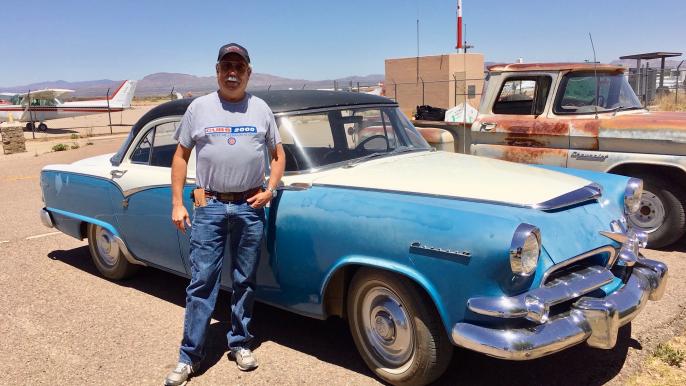
One of the best ways to experience classic cars may be to borrow an FBO courtesy or crew car. Of course, convenience—not nostalgia—is the reason for borrowing a crew car, especially when flying to a destination where an Uber, Lyft or rental car may not be readily available. Many FBOs around the U.S. provide visiting pilots with a courtesy car free-of-charge for a few hours’ duration, assuming the borrower replenishes the gas tank and observes other basic etiquette. As for the automobile, the Aircraft Owners and Pilots Association (AOPA) advises that pilots arrive with measured expectations.
“The car may be a tad musty, the gear shift may feel a little loose, or require a non-standard maneuver to engage it,” AOPA web editor Jim Moore wrote in a 2018 blog post. “You may hear some unnatural sounds after turning the key, sounds that may or may not go away after the car warms up. A sense of humor may be required, particularly if heading downtown where people will see you driving such a vehicle. The car may be older than the airplane you flew in, which is often saying something.”
Typical among crew cars is the Ford Crown Victoria, which may have been decommissioned by a police department and acquired at auction. The last Crown Victoria rolled out of Ford’s St. Thomas, Ontario, assembly plant in September 2011, after which the Canadian facility closed. “The smaller county and city airports—they’re the ones you see with the old Crown Vics that used to be cop cars,” says Glenn Brasch, who administers the website, Airport Courtesy Cars. “The bigger FBOs are supplying their own,” Brasch adds.

Crew Car Databases
Airport Courtesy Cars (https://www.airportcourtesycars.com) is readily found online, where other information about crew cars appears dated. Organized by state, Brasch’s donation-supported website lists 2,042 crew cars nationwide, available from 1,500 airports, as well as 82 Mogas locations. It features a comment section where pilots describe first-hand experiences with FBOs and courtesy cars.
Another on-line resource is the AOPA Airport Directory (https://www.aopa.org/destinations/), which includes “courtesy car” among searchable amenities.
A former medevac helicopter pilot and flight instructor, Brasch founded his website—originally as an app—in 2014. “I was flying to Oshkosh that year and I was planning a trip from Arizona and looking for where I might stop to have a courtesy car,” he recalls. “I thought there must be some listing somewhere, and there wasn’t that I could find. I started putting out feelers on different forums and within months, I had about 700 listings.”
Brash notes that he offers FBOs low-cost advertisements to appear on the website, which has become indispensable for some pilots. “I had a factory pilot who worked for one of the aircraft manufacturers,” Brasch says. “And he basically told me one time, ‘I ferry aircraft and I use your website for flight planning.’ That prompted me to put a little note in there saying: please do not use my website for flight-planning only.”
After reading about a string of thefts of crew cars, Brash no longer includes instructions on the website for how to access them. “People used to say, use the VFR squawk code to get in the door, and then there’s a lock box underneath the seat, and press 1,2,3 and the keys are there,” he says by way of example. “People sent that information to me, but after I read that story, I don’t put anything like that in there.”

FBO Crew Car Policies
The first rule of thumb for crew cars is to contact the local FBO in advance to inquire if one is available, after which basic etiquette applies—leave the car as clean as you found it and put some gas in the tank—AOPA advises.
Other requirements are specific to the host destination. Fly High Lexington, the FBO at Davidson County Airport (KEXX) in Lexington, North Carolina, 24 mi. south of Winston-Salem, maintains a fleet of four crew cars—one Buick, one Chevrolet Tahoe and two Crown Victorias, including one with a spotlight that served as a Police Interceptor.
“Our policy is the crew car is free for up to two hours of use with fuel purchase,” said Fly High Lexington General Manager Jack Robertson. “If no fuel is purchased, we will charge a small fee to cover the use of the car. Typically, if the pilot brings the car back full of gas, we waive the fee. We have routine users who will fuel the car and run it through a car wash every visit, regardless if they need fuel in their aircraft.”
Fly High Lexington can also make arrangements for pilots who need a crew car for longer periods of time. The FBO collects the user’s name, phone number, tail number, check-out time and the specific car used.
Among other conditions, based on a random sampling of crew car policies, Perryville Regional Airport (KPCD), in Perryville, Missouri, offers the use of a car on a first-come, first-served basis; requests that it be returned in four hours; and prohibits users from smoking or consuming alcohol or drugs while in possession of the vehicle. Monroe County Airport (M40), in Aberdeen, Mississippi, lists similar prohibitions and forbids the use of a cell phone or earphone equipment while driving. “If driver concludes that the courtesy car or conditions are unsafe, the final decision rests with the driver,” the airport counsels.





